[ad_1]
lead image by @gc911
The 2010s end tonight.
Yup, the decade that just was is no more at midnight, but has there ever been a more important decade in sneaker history than the one we just finished?
Sure, the ’80s brought us Michael Jordan, Nike Air and the man who tied them together – Tinker Hatfield. The ’90s were no slouch either, seeing MJ’s influence explode the signature shoe category, Air technology both thriving and evolving, and brands like Reebok, adidas and others choosing to ride the wave of endorser driven-product and eye-catching tech.
The ’00s? Well, a lot happened there, too. Sneaker culture as a sub-culture grew denser, deeper and more concentrated once Mike retired. The rise of the internet saw forums like NikeTalk and InStyleShoes make collecting and trading a global game, the Dunk become a skateboarding shoe and artists like Eminem, Jay Z, 50 Cent, Pharrell and Kanye West scored their first collabs. Oh yeah, a kid by the name of LeBron was drafted and signed by Nike for a bit of money, too.
All the awesomeness of the ’00s exploded in the ’10s though. Bigger, faster and stronger, forums became blogs and blogs became YouTube channels, Instagram accounts and Reddit threads. Shoes were no longer sold secondhand via Avatars and money orders but rather through Facebook groups and soon StockX. The rise of resale created a cheesy caricature of capitalism, but it also provided 24/7 access to grails, a legal hustle for the youth and pressure on the brands to produce more. Also, an artist who we may have mentioned before became by far the most important person in footwear only to switch sponsors, become a billionaire and see both his right-hand man and protege ascend to similar heights.
So, what shoes made this decade so important? What shoes shifted the market, influenced sport, fashion or even created categories? Well, we have our Top 20 list below.
Enjoy. Share. Debate. Hate. Thanks for making the 2010s an amazing decade for the Nice Kicks Family.
20. adidas Yeezy Boost 350 V1/V2
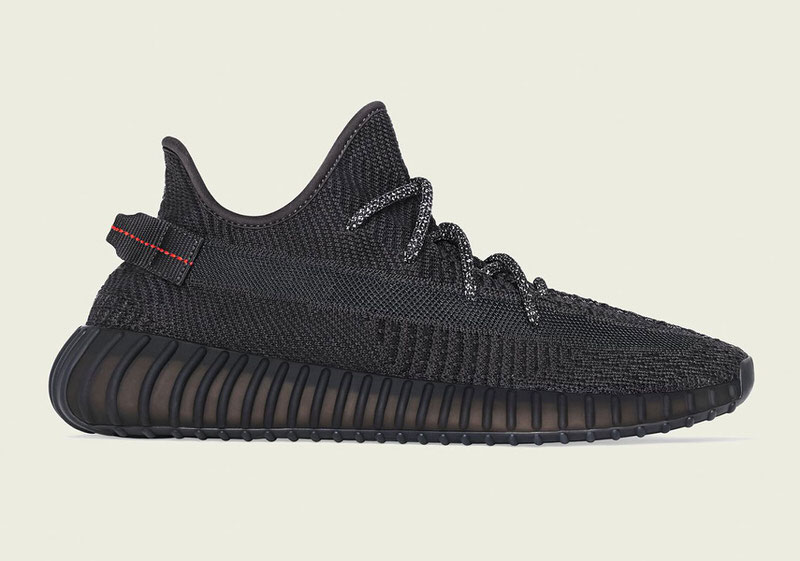
All-Star Weekend 2015 in the Mecca of hoops – New York City – will not be remembered for basketball.
It will be remembered for Kanye West.
With the world watching and NYC hosting both ASW and Fashion Week, Kanye West debuted his first round of footwear with adidas and YEEZY Season 1 clothing collection in The City That Never Sleeps. Following 2011’s Paris panning only to be amplified by recent radio rants and Yeezus Tour monologues about Mark Parker and Nike, the likes of Anna Wintour were in attendance and the likes of Matt Powell were betting against him in what was certain to be another big moment.
Upon unveil, the oversized, utilitarian athletisure outfits were made into memes and perhaps to pricey for retail. Less Polo, more Hobo, West’s phase 1 efforts to democratize fashion were met with discounts from shoulder to shin. Always a fan of film, he reminded doubters – and perhaps himself – that when it came to footwear the critics could derelicte his balls.
At the time of the show and All-Star Weekend, the shoe was the adidas Yeezy Boost 750. The first formal release from adi and Kanye, the shoe would cause commotion and blow all other All-Star releases out of the water. Rumor has it that Nike even considered rushing the auto-lacing MAG as a counter tactic to the Yeezy hype. Also treading on the moment in the competition space was the release of Drake’s If You’re Reading This It’s Too Late.
While the 750 wasn’t for everyone, the other sneaker the fashion show spawned was. The adidas Yeezy Boost 350, a low-top slip-on style similar to many other sportswear silos of the moment, would go on to sweep the masses.
First rolled out in subdued palettes then later revitalized in louder V2 styles, the combination of Kanye, Boost and Primeknit at a price-point just north of $200 proved more accessible and digestible than any Yeezy before and any Yeezy since. As polarizing as Kanye was and as popular as Kim K remains, the 350 hit damn near every demographic in regards to consumption whether pairs were flipped or fugazi. Heck, the NFL even knocked them off.
What hasn’t been knocked off yet is the 350’s staying power as it caps off the decade still on an uber impressive five-year run. Say what you will about the countless colorways that couldn’t be closer to each other, but the 350 remains more relevant and more requested amongst the masses than any new design this decade.
19. Travis Scott x Air Jordan 1/Off-White x Air Jordan 1
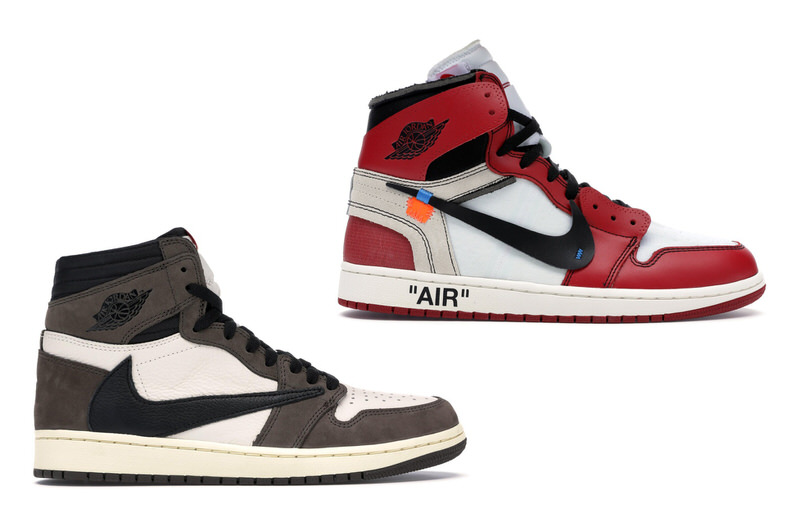
The front half of the 2010s may have belonged to Kanye, but the latter years saw the rise of his friends.
From Ibn at Diamond to Don C at Jordan to Jerry at Nike, his longtime buddies and guiding hands in fashion found success in sneakers with their names on products and followings on fleek.
Ironically enough, it would be his right hand man and protege who would dominate the end of the decade on the footwear front. Even more ironic? They’d both do so most notably by flipping the shoe made famous by Kanye’s hero in the 1980s only to be revisioned for lifestyle wear by Kanye himself in the 2010s.
Both Virgil Abloh and Travis Scott received creative control on the Air Jordan 1 that might make Kanye jealous and sure made Mike lots of money.
Allowing Virgil to deconstruct the Chicago OG and Travis to both invert the branding and add a stash pocket, the 30-something sneaker was made modern and coveted to kids ready to cough up a lifetime’s supply of lawn mowing money.
18. Nike Air Monarch
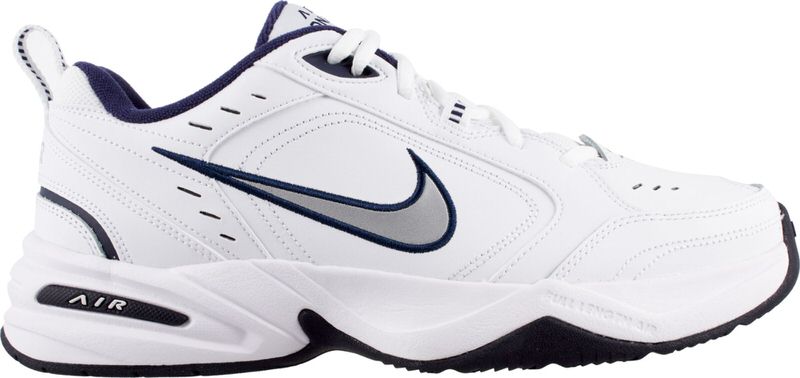
Instagram will go down as the most influential social media platform of the 2010s for both better and worse.
Before grandmas and go-getters were racking up likes with selfies on IG, cool kids ranging from A$AP Yams to VFILES favorites were curating taste on Tumblr. While the former finds himself at the forefront of the cozy boys movement that laid the groundwork for athleisure in regards to laid backness the latter and its contemporaries could be credited for Normcore.
What’s the deal with Normcore? Essentially, it involved dressing like a middle-class mom or dad from the ’90s with the Seinfeld swag of dad jeans and potentially a turtleneck t-shirt, Oxford button down or crewneck sweatshirt. It was a stark contrast to the early-10s obsession with loud leather, cheetah print on people that had never been to the jungle, elongated cuts and overemphasized butts.
While dirty white AF1 Lows were trending on Tumblr among Normcore enthusiasts in NYC, a similar movement was taking place out in Portland. Team Monarch – founded by our main man Ian Williams of Deadstock Coffee fame — was championing the most Normcore dad shoe of all-time right around the same time Tumblr tykes were wearing Champion sweatshirts like Tim “The Tool Man” Taylor.
Ironically enough, the tool for the rise of Team Monarch was that of Instagram. Capturing the kicks sold at Kohl’s on the feet of Danny Tanner doppelgängers in the wild, suddenly celebrities like Drake were popping up in pairs and Pete Carroll was getting PEs.
The ultimate example of ironic fashion? Perhaps. But let’s not forget the fact that the Monarch had long been a hot-seller amongst the masses due to its incredible comfort, value cost and simple aesthetics. Before long, the Monarch became so hot thanks to the internet that athletes like Russell Westbrook were rocking customs in the tunnel and Foot Locker was stocking the shoe not to hedge on Home Depot shoppers but actually stay a step ahead of Journeys.
Pundits will debate if Dad Shoes are the best or worst trend of the 2010s. But like any good dad joke the Monarchs are still just as inoffensive as they are funny.
17. Balenciaga Triple S
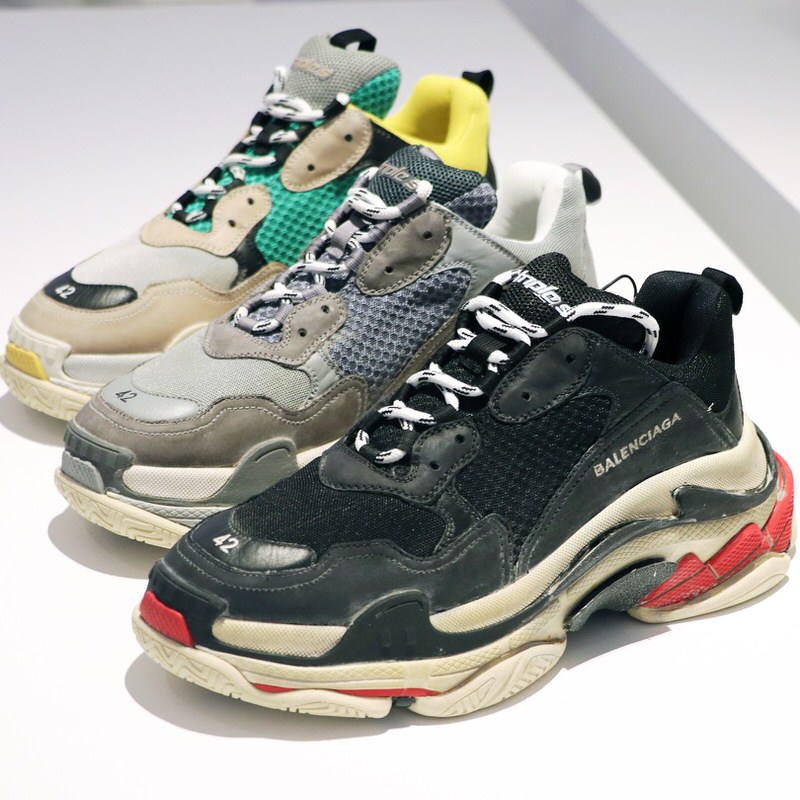
When sneaker culture as we know it started taking shape in New York City in the ’80s, ballers and break dancers alike were chasing cardboard classics made famous by Mike, Run-DMC and Clyde Frazier. While heroes in hoops and hip-hop were domestically dictating what was cool to the masses, players in another game were leveling up the price-point and palette by way of international designer drops like the Gucci Tennis from Italy or Bally sneakers from Switzerland.
For the decades that followed, the rappers would follow suit of what the hustlers wore and the hoopers would copy just the same. However, outside of a Prada America’s Cup or a Hova homage to Gucci by way of Reebok, designer shoes were simply not cool to sneakerheads who were more moved by Air Jordans and SB Dunks.
Early in the 2010s that began to change with Balenciaga. With rappers totally taking the juice from hoopers in regards to style influence and the cream of the crop in hip-hop regularly attending Fashion Week, the Arena would become popularized by Kanye West and bought up by every stylists for the stars.
While the Arenas opened the door and the “ones that look like socks” spawned every level of imitation, it was the Triple S that really shook shit up. Taking the dad shoe trend to new heights literally and figuratively the stacked sneakers that fetched far more than a stack stand as perhaps the most polarizing shoe of the decade that just was.
As time passes, it will be interesting to see if the Triple S ages in favor like a futuristic Foamposite or feels more like the overpriced equivalent of a Tech Vest. Nevertheless, the Triple S is the designer sneaker that will be most remembered from the 2010s.
16. Air Jordan 1 Shattered Backboard
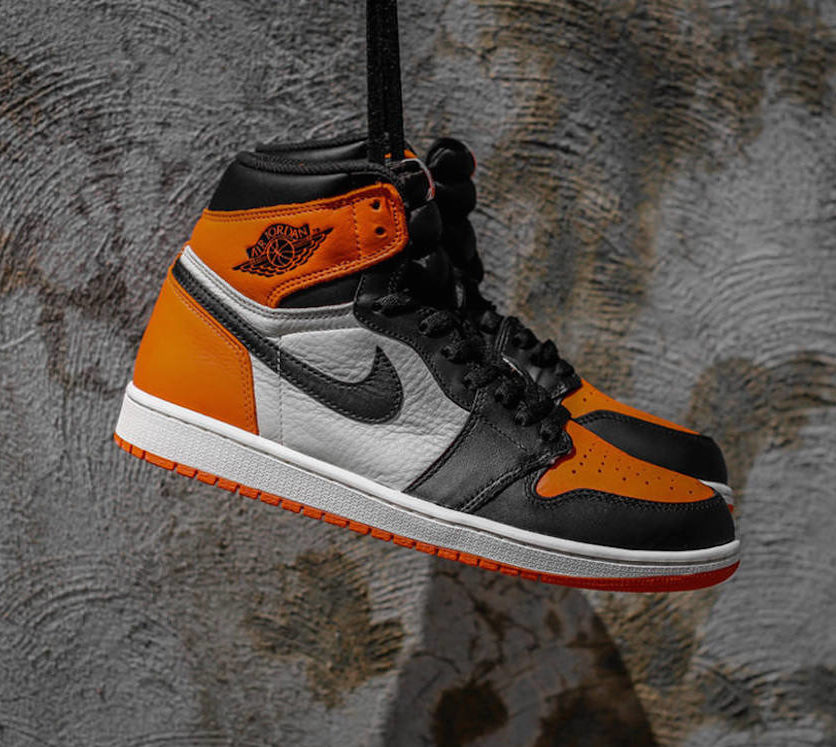
2015, by most measures, was about adidas.
The brand had finally released product by Kanye West, debuted the Ultra Boost and settled into their mantra of “We Are The New.”
For the first time in years, Nike was not the talk of the market and retro Jordans releasing at new ‘remastered’ price points saw once coveted classics sitting on shelves and losing almost all appeal to hype hunters bent on wearing or selling what others couldn’t cop.
Almost all remastered retros but one.
The Air Jordan 1 High “Shattered Backboard” was perhaps the most unexpected hit not just of 2015 but of the entire decade when considering old silos. Telling the story of Mike’s memorable – but mostly unknown – exhibition dunk in Italy that saw a young MJ’s will to win as much stronger than that of the system, the moment from ’85 mirrored that of ’15 as Jordan was steady forecasting the future while the rest of the world was watching something else.
Creating appeal for non-OG colorways on the Air Jordan 1, returning an appreciation for standards of quality and validating Black Toe blocking, the SBBs paved the way for celebrated sequels, orange as a hot hue before VLONE popped or Pablo dropped and later launches like the “Bred Toes,” “Court Purples” and plenty of pairs that followed the same formula.
Broken glass everywhere, collectors are still picking up the pieces of the greatest story that prior to 2015 was never told.
15. Under Armour Curry 1
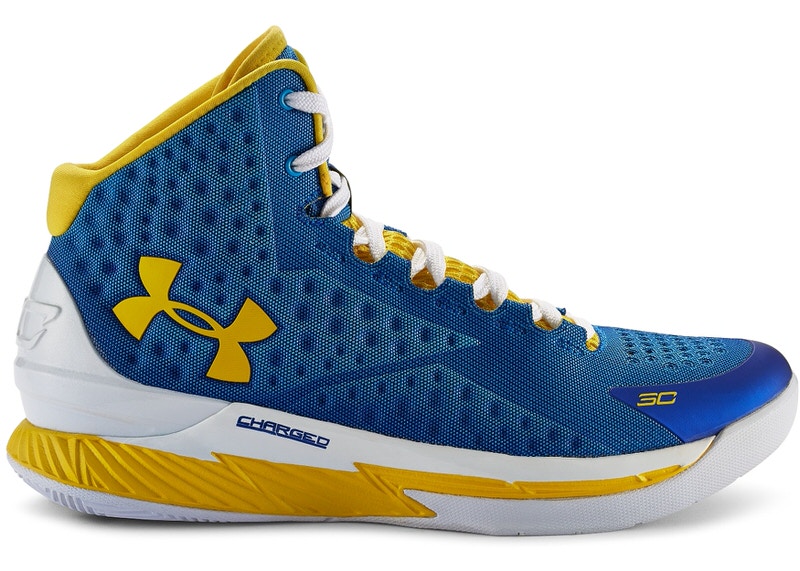
Charles Barkley famously stated he was not a role model.
Steph Curry? Well he definitely is.
Grant Hill in manners, Allen Iverson in stature and Pistol Pete in skill, Steph Curry has rings that rival Mike and an image on point with Obama. Like most of us, Nike did not forecast this and Under Armour effectively won the lottery by landing a truly transcendent talent.
After some early fails in footwear circa the late 2000s, Under Armour aimed to be more than football, more than middle-America and more than just compression gear in the 2010s. Focused purely on performance for the first half of the 2010s without chasing denim like the market, UA’s steady improvements and clear focus matched with the same ethics and ascent of Steph all culminated in 2015 with the Curry 1.
Releasing far after Steph was a rookie but right when he was new to the world at large, the Curry 1 released at the perfect time. Not only did UA have a hooper that was validating their product on the world’s biggest stage, they had an athlete and person who aligned with their brand. Quickly the world found out UA was capable of making good shoes. Just as quickly UA found out it was best to stay in their lane and avoid lifestyle plays or half-baked stories.
Still, the Under Armour Curry 1 not only proved UA could hang in the footwear game it even saw them dip their toes in the ranks of resale. Imagine that? As Under Armour enters the new decade with a new CEO at the helm, they’ll still have the same incredibly likable sharpshooter who’s validated their basketball category for years to come.
14. Air Jordan 11
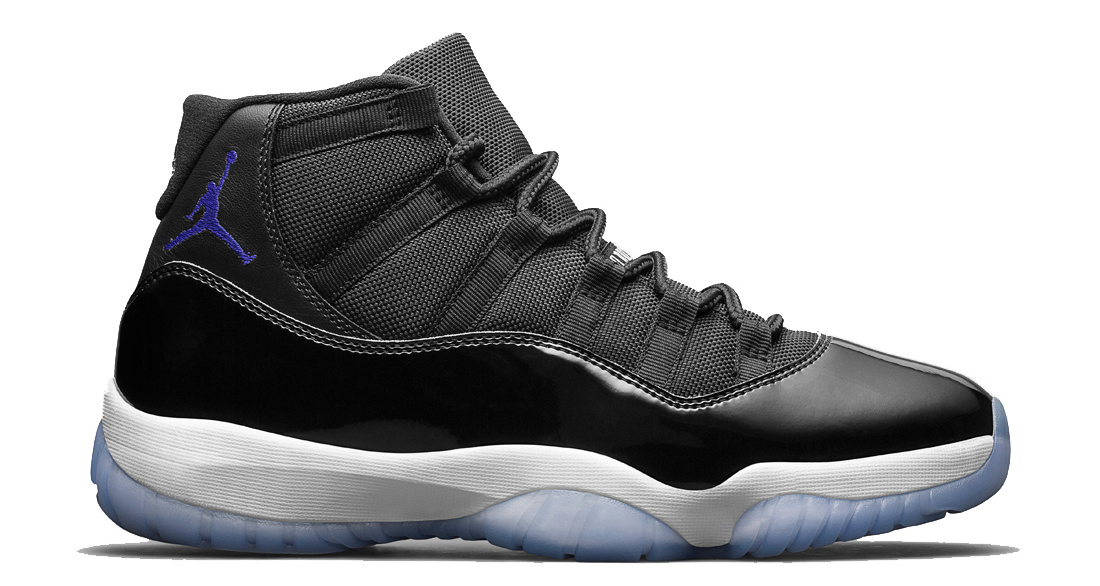
The Air Jordan 1 made Nike matter and the Air Jordan 3 kept Mike at Nike, but the Air Jordan 11 is the only model in the infamous signature series that’s remained red-hot and relevant literally every day since its unveiling.
Shortly after ’94 retros flopped when MJ traded his basketball for a baseball bat, the greatest player to ever hit the hardwood returned and shocked both the world and Nike execs by breaking out the Air Jordan 11 in the ’95 Playoffs. The Bulls would exit early but the shoes wouldn’t release for months. By the time they hit the market that fall, MJ and Co. were in stride to take the Bulls on the best regular season and championship run the league had ever seen.
After only a few years off the market and with Mike back in retirement, the Air Jordan 11 would return to retail in 2000 and absolutely crush as other ‘old’ sneakers were still finding their footing. This trend of the 11s causing absolute madness in OG and new colors alike would continue throughout the entire 2000s but really explode in the 2010s.
From the “Concord” comeback of 2011 to the record-setting “Space Jam” drop in 2016, the Air Jordan 11 mattered every year regardless of how many pairs were produced. In some form or fashion, every OG smoked while new takes like the “Gamma Blue” or members of the “Win Like” series still outperformed peers still active in the game.
It’s gotta be the shoes and in the 2010s it still had to be the Air Jordan 11s.
13. Sean Wotherspoon x Nike Air Max 1/97
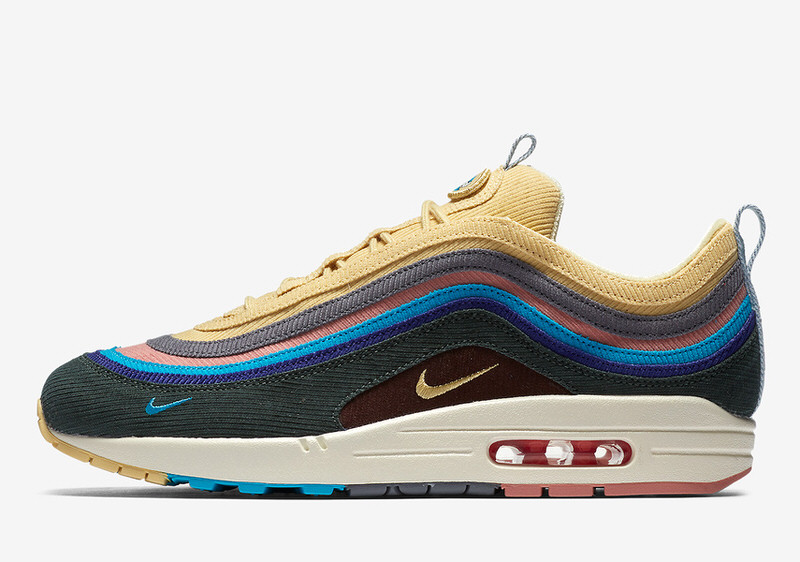
A quick Google search suggests Sean Wotherspoon weighs in at roughly 5’8 and a likely generous 175 lbs. His Wikipedia page will list no NBA championships, no Grammy awards and no degree from Parsons. A quick Google search will also tell you that Sean Wotherspoon is the designer of the most popular sneaker of 2018.
Just like you, just like me, Sean Wotherspoon is a sneakerhead and amazingly ambitious one at that. Long before he’d do for corduroy what Mike may have done for patent leather, the thrift hunter was dipping Supreme Jordans in red paint and painting his hometown of Richmond red with a consignment shop called Round Two.
While vintage shops have been around since clothing was seasoned enough to be considered old, you couldn’t exactly walk into a local Goodwill or even second-hand boutique and expect to find a Ma$e shirt or some SB Dunks. Curating vintage through the eyes of an ’90s baby and documenting it all through the platform of YouTube, the shop’s enthusiasm for the ‘new old’ and the show’s following by today’s youth inspired many an adolescent to open up their own shop and the boys in Beaverton to open their doors to Sean.
Winning Nike’s first On Air fan voting contest for Air Max Day, Sean reimagined the future of Air by redressing its past. Smashing the Air Max 97 upper on an Air Max 1 sole and blasting it in ’70s style corduroy for a funky finish, the shoe served as a symbol not only for what kids are on now but what kids truly believe they can do.
Heading into the next decade with more Round Two stores and anticipated collab with ASICS, it shouldn’t be forgotten that despite getting his own shoe and appearing in nationally televised Nike commercials, Sean loves shoes just the same and stood up to Nike for the rest of us when most would’ve folded for a check – no pun intended.
Sean Wotherspoon: one of us, for us.
12. Nike BETRUE x EQUALITY x Kaepernick
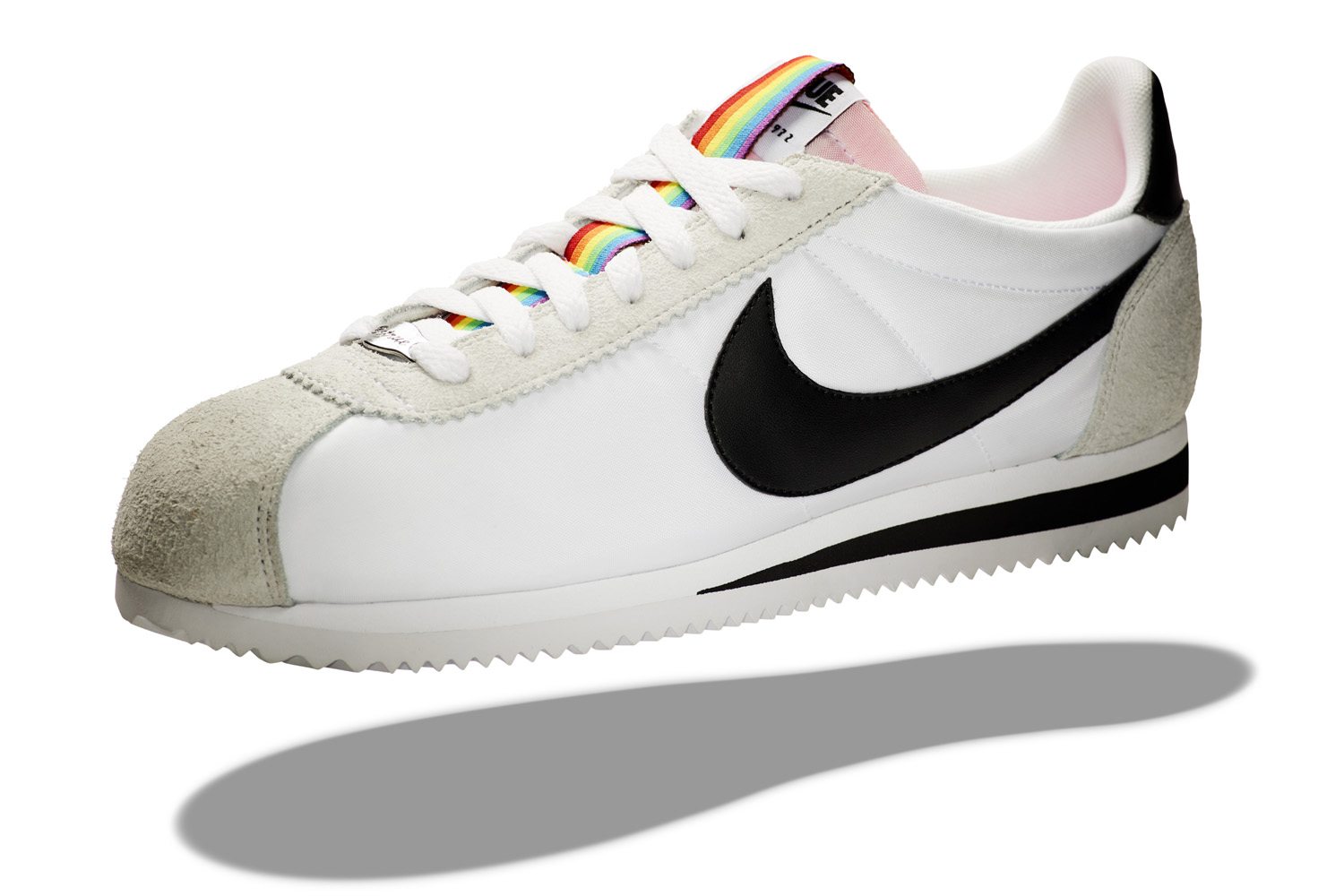
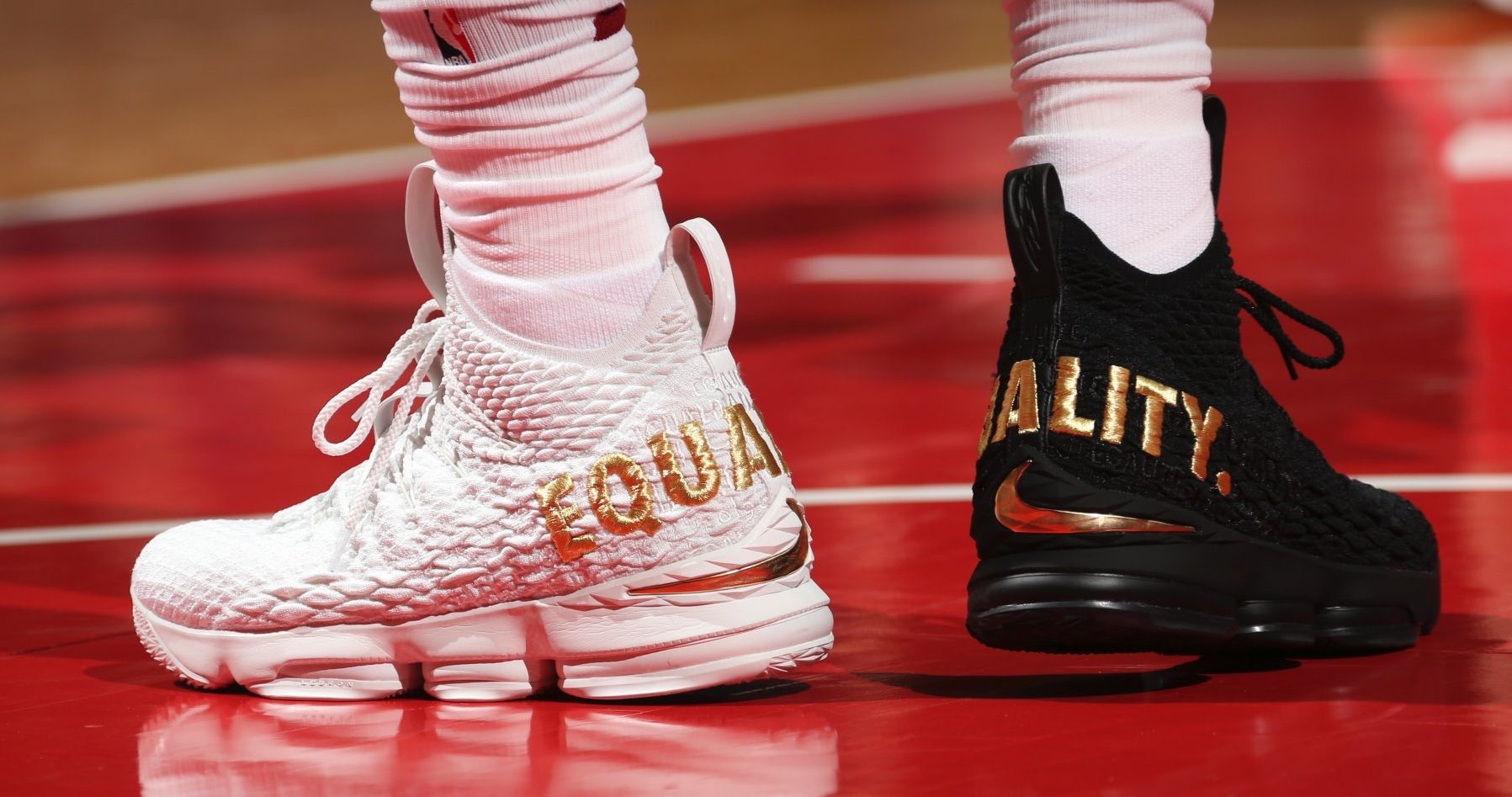
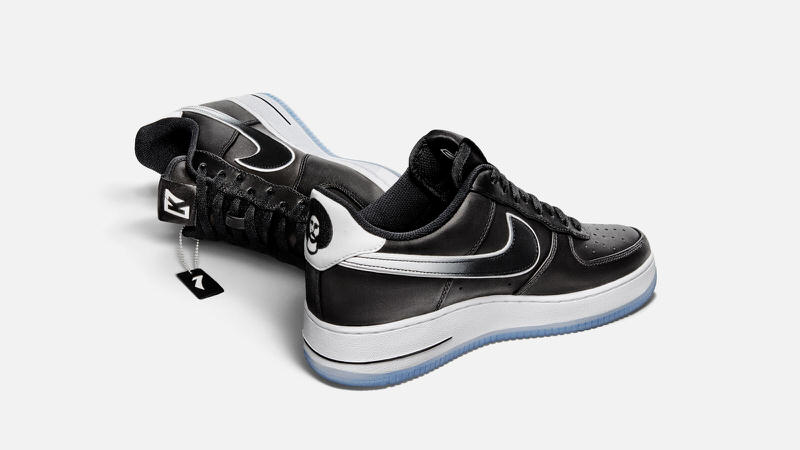
Social media and social justice will more likely than not be the two terms that define the 2010s.
By products of the information era and an America that sometimes feels like it’s splitting at its seams, of all the brands in our capitalistic country Nike proved the boldest, smartest and savviest at entering the tough conversations about injustice and getting supporters to buy products just the same.
First, it was the BETRUE collection. While Be True had long been likened to the Be True to Your School campaign for Nike NCAA Basketball in the ’80s, it was beautifully rebranded in the 2010s by the Swoosh as a way to empower and promote rights for gay, lesbian, queer and transgender people. Nike has long said if you have a body you’re an athlete. With BETRUE they reminded us that if you’re into shoes you’re a sneakerhead and that all are welcome.
Coming off the most polarizing election – umm – ever, Nike launched their Equality campaign in February of 2017. Taking the message of previous Black History Month collections, tying it to current conversations and making it year-round, suddenly LeBron James was playing in politically aware shoes in the nation’s capital and every Nike basketball bench from Durham to Columbus was wearing the message EQUALITY in all caps in their team colors.
To close out the decade and double-down on their stance, Nike teamed up with athlete/activist Colin Kaepernick for an Emmy winning campaign that was just as powerful as it proved polarizing. Even with politicians, media outlets and customers slamming the Swoosh and swearing they’d never wear it again, Nike remained on their path just the same, supporting Kap and his cause.
In an era where conversation was as loud and divisive as could be, Nike willingly entered the middle of it and lived up to their Just Do It motto all the same.
11. Vans Old Skool
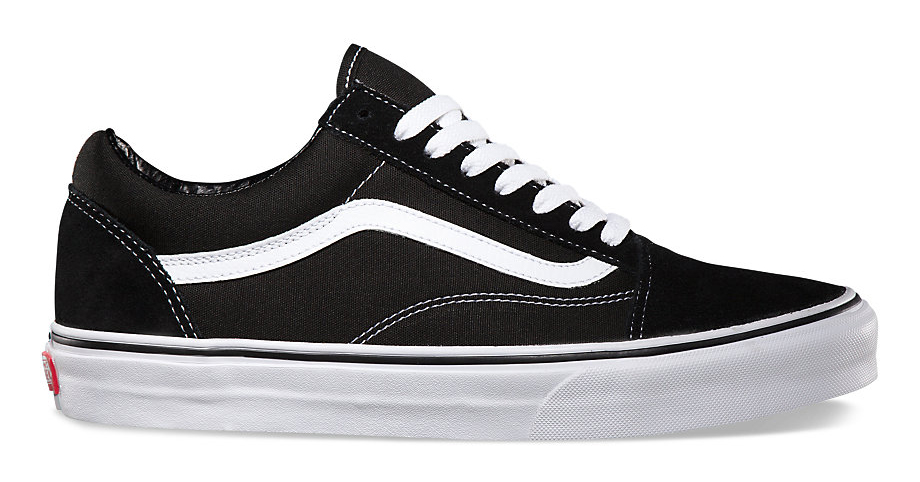
Technically speaking, the Vans Old Skool debuted in 1977. Historically speaking, it came into its own in the 2010s.
Years after The Pack paid homage to Steve Van Doren’s skate shoes, the brand’s simple but boldly marked Old Skool silo became the staple for a new generation. While redressed by the likes of Opening Ceremony and Supreme and endorsed by the likes of Tyler the Creator, Travis Scott, Frank Ocean and even Kanye West, the Old Skool effectively proved to be to the 2010s what the Air Force 1 was in the 2000s.
Wait, what? Hang with us for a second.
In a decade where everything was seemingly flipped, opposite or odder than what we once knew, the Old Skool was at the center of it all. Worn by all and afforded by all, the Old Skool spoke to a generation of kids that wanted to wear Nike socks with Vans sneakers and adidas track pants at the same damn time. They spoke to a generation more influenced by Tyler and Frank than Puff and Big. They spoke to a kid who cared a lot about expression but not at all about impressing. The Old Skool could be skated in, painted in and worn until completely based backed when some considered AF1s cooked after one wear.
More about being young and less about looking made, the Old Skool is the shoe of the Odd Future we preside in today.
10. Ronnie Fieg x ASICS Gel Lyte III
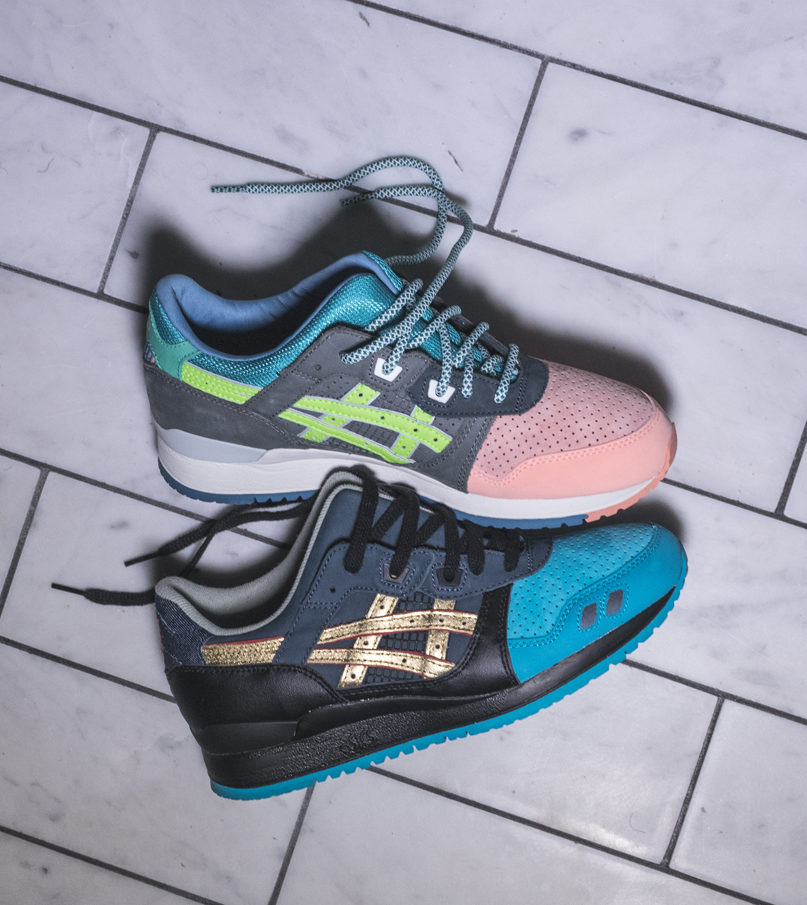
In the early 2000s when young adults that lurked NikeTalk would congregate at the malls of America at 6 AM when only elderly walkers roamed, it wasn’t uncommon for a curious power pacer to ask just why they were standing in front of the Foot Locker or Finish Line at such an early hour.
An honest man might answer, “To buy the new Jordans.”
A smart ass might say, “To buy some New Balances.”
By the turn of the 2010s, one whiz kid from Queens would cause hysteria and add credence to that smart ass’s quip.
His name was Ronnie Fieg and his game was retro running.
Coming up as a stock boy under his uncle David Z, a teen Fieg would find financing for his own shoe habit when a frequent customer by the name of Jay Z – no relation – would re-up on Timberlands each week. As Fieg grew older so did his aspirations, leveraging his David Z connections to collaborating with ASICS in the late ’00s and going absolutely HAM in the 2010s.
A master marketer and a true New Yorker, Fieg’s appreciation for heritage quality and understanding of new age advertising saw him redressing retro runners from ASICS in the poshest of palettes and lushest materials to the tune of coverage on every major blog in the fashion space. Making connections with NY’s elite in music, fashion and media, suddenly the whole city was behind Fieg once it was time to open the doors to his own store, KITH.
While what Fieg has done with KITH is incredible and almost impossible to list in one paragraph, it’s what he did with ASICS that truly shifted the market as a whole. By making what were once considered old man shoes young, hip and sought after, an entire market absolutely exploded for the category. At the same time Ronnie had kids lined up around the corner for “Salmon Toe” Gel Lytes, New Balance was tapping CNCPTS’ Frank the Butcher and Burn Rubber’s Rick and Ro for the most compelling lifestyle product they’d done in ages. Suddenly inline ASICS and New Balances were becoming cool again amongst young people and heritage brands like Diadora and Saucony were looking to score on the same formula Fieg fixed up with ASICS.
Over the course of the decade, Fieg has proven to be much more than one brand, one category or even one lane. He’s been called on by the likes of LeBron James, Tommy Hilfiger and even Coke to add that same sense of luxury and heritage he knows so well.
While Fieg’s run continues, it was his early work with ASICS that exploded a category and kicked things off for brands far beyond it.
9. Nike Flyknit Racer & Flyknit Trainer
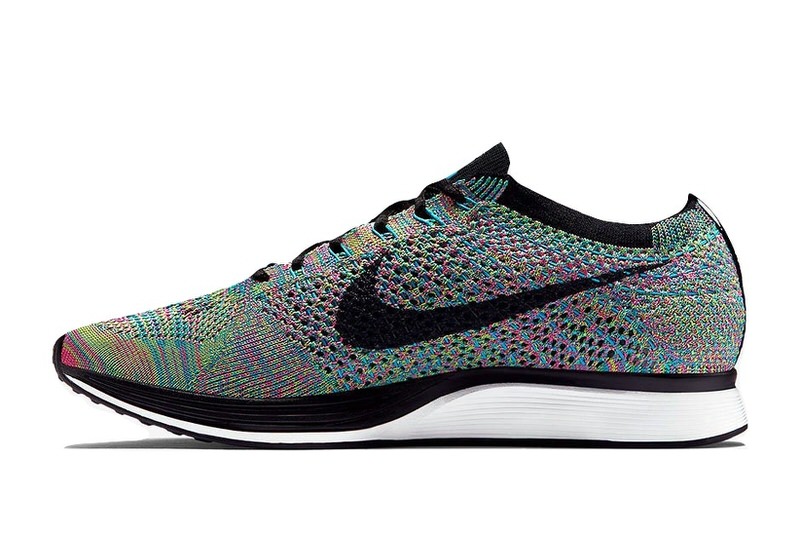
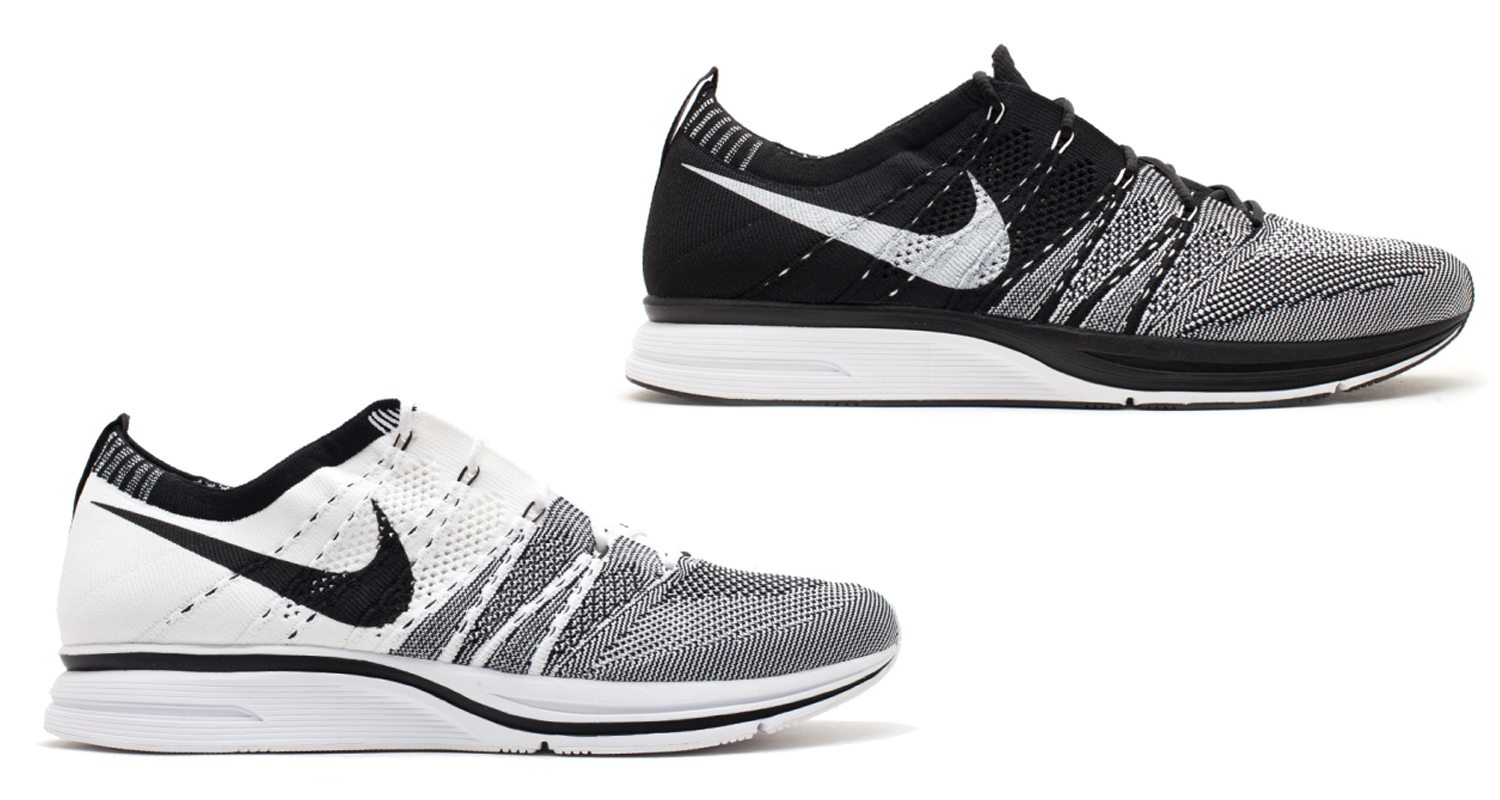
The Nike Flyknit Racer and Flyknit Trainer debuted just in accordance with the 2012 Summer Olympic Games. With that said, don’t ask any runner about breaking their best marathon time in the Racer or a lifter about setting a new squat record in the Trainers.
As far as athletic achievements, the Flyknit Racer and Trainer had few. In regards to shifting the market, both models achieved plenty.
Likely due to increasing costs on leather sourcing but possibly inspired by actual athlete insight, Nike’s Flyknit threading and adidas’ soon to follow Primeknit construction totally revolutionized the way shoes looked and felt. For years, all the innovation went into the sole of a shoe. Suddenly in the 2010s, changes of actual magnitude were happening on the upper.
Spearheaded by the Swoosh and copied by everyone from Reebok to Skechers, knit uppers were suddenly the new standard and motifs like “Oreo” and “Multicolor” were suddenly the new wave. While version 1 Flyknit may have sucked for actual sports, upgraded iterations seen on the likes of the Kobe 9 and Mercurial cleats propelled some of the best athletes this decade saw. And oh yeah, Kanye wearing these helped a bunch, too.
While function is yet to be proven on VaporMax and React does nothing for the eyes, Flyknit has proven to become an eventual winner in the long run in respects to both performance and aesthetics. Maybe that’s more important than winning the first sprint.
8. Nike Free Run 2
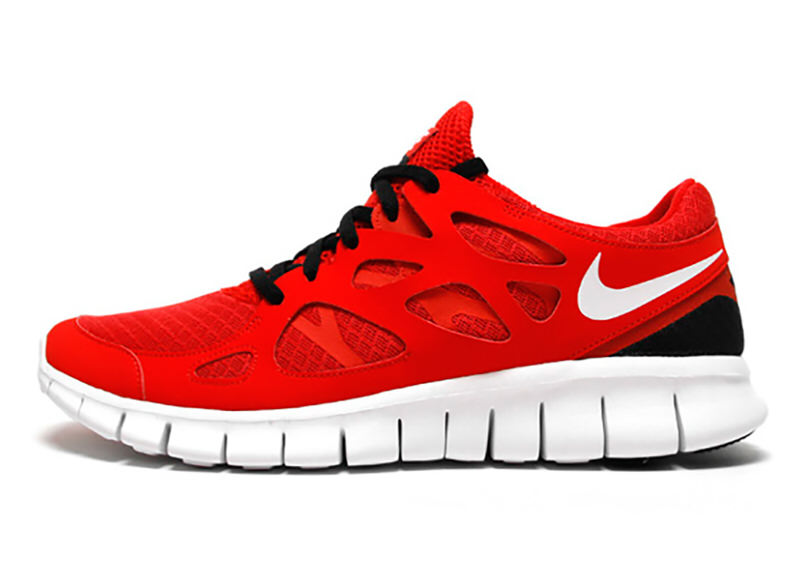
Very rarely does a shoe become very sought after that isn’t very rare. In 2011, that’s very much what happened with the Nike Free Run 2.
Releasing six years after Nike got their feet wet in the barefoot running game, the release of the Free Run 2 would ironically hit at the same time full-length Air and $160 price points were once again exploding. Hitting on the heels of the Air Max 2009’s crossover success and LeBron James’ signatures finally getting burn with jeans, the Free Run 2 had no chance, right?
Wrong.
A smash hit from soccer moms to suburban kids who rocked Elite socks to private school, the Free Run 2 was somewhat safe in regards to price but somehow both aggressive and minimal in design. In fact, the design’s upper was so celebrated that Nike literally lifted it, put it on a full-length Air sole and called it the Air Max 2012. Look it up, it really happened.
Safe enough for the suburbs but not without steeze or function, the Free Run 2 did little for the barefoot running movement but got traction in just about every town in America. The shoe was so hot that it’s designer – Mark Miner – was eventually poached by adidas and brought over to work on Yeezy with the likes of Kanye West and Steven Smith.
7. Nike Air Foamposite One Galaxy
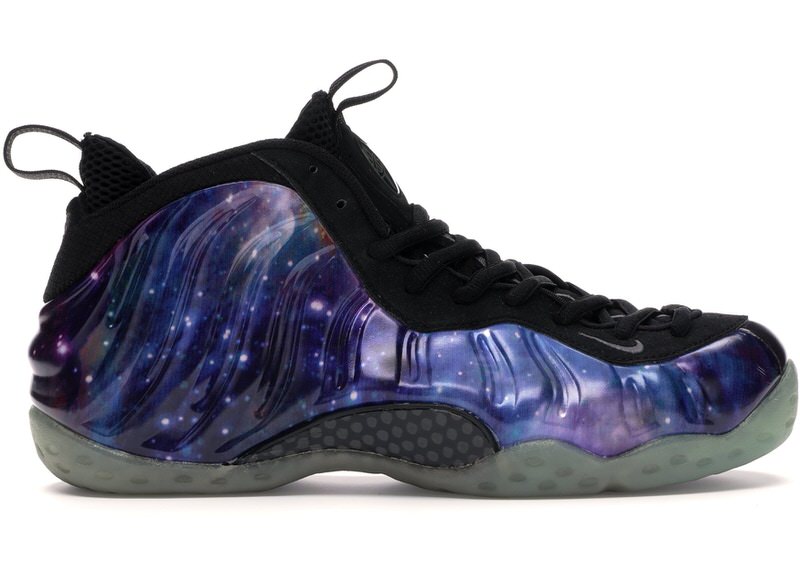
Back in the 1990s, Sports Illustrated poised a sad and scary question: your shoes or your life?
In 2012, the Nike Air Foamposite One “Galaxy” asked a far more tamer one: your shoes or your car?
Taking the superpowers of Penny Hardaway and Wale Folarin into outer space, 2012’s All-Star Weekend “Galaxy” Foamposite One was famously traded on Craigslist for an actual motor vehicle. Its enormous impact on the buy, sell, trade aftermarket not only rewrote the rules on resale it changed operations at retail.
While we don’t like to glorify riots, violence or really any bad behavior, the Galaxy Foamposite One release proved something: the financial come up from copping a pair of kicks had literally soared to dangerous heights and serious cash. Following campout madness in the All-Star home of Orlando and seemingly any other city that got a size run, it was clear that the decades old system of ‘first come, first serve’ was no longer safe or sufficient.
Perhaps the Pigeon Dunk for the 2010s, the Galaxy Foamposite was untied to one city or one store but rather a universal game-changer. Though the Foamposite hysteria would peak with said shoe, the way retailers sold shoes and the reasons people bought shoes would never be the same.
6. adidas NMD
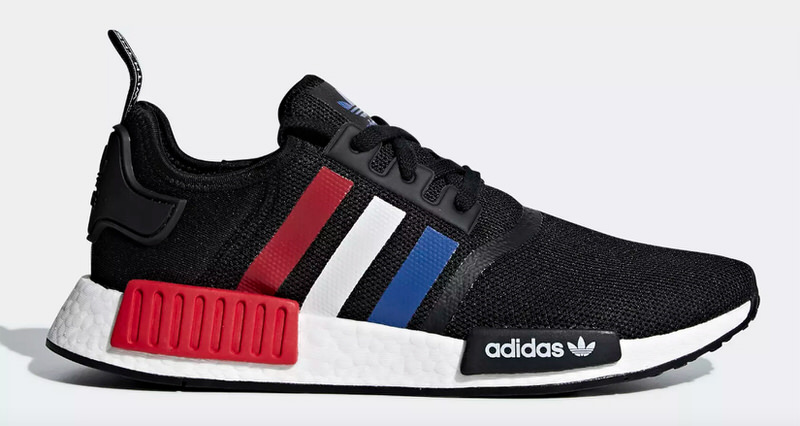
By the halfway point of the 2010s, adidas had lots of momentum. Pairing flash with function, the Three Stripes honed the notion that artists were the new athletes by bringing on the likes of Kanye West and Pharrell. Providing the steak to the sizzle, adi also honed the hottest innovation in the game: Boost cushioning.
Merging the fashion friendly ethos of their Originals line with the performance pellets packed in the Ultra Boost, adidas released the NMD: a modern model made for the city trekker that valued feeling comfortable as much as they did looking cool.
Unveiled in NYC at the tail-end of a blockbuster 2015, the NMD would go on to stomp the city and the suburbs for all of 2016. From malls to boutiques, IG models to hip high schoolers, the NMD captured the moment that was athleisure, blurring the lines of who and what was cool while adding new credence to the term ‘fast fashion.’
Created by Nic Galway of Y-3 and Yeezy fame, the sleek sneaker removed the insole to place Boost right against the foot while the model’s midsole plugs provided color blocking capabilities even the Air Max 90 would desire. Like the 90, the model’s retro running inspiration and actual tech made these the People’s Champ. Unlike the 90, truly up to date comfort and a canvas of an upper that could take to every modern material and print made these more advanced than anything we’d seen before.
While many shoes on this list lasted the course of the decade, none can claim to dominate an entire year like the NMD did. Erupting at retail from suburban stores at the mall to coveted collabs with BAPE at boutiques, the NMD owned all of 2016 in a manner we hadn’t seen before and haven’t seen since.
5. Nike Air Yeezy 2
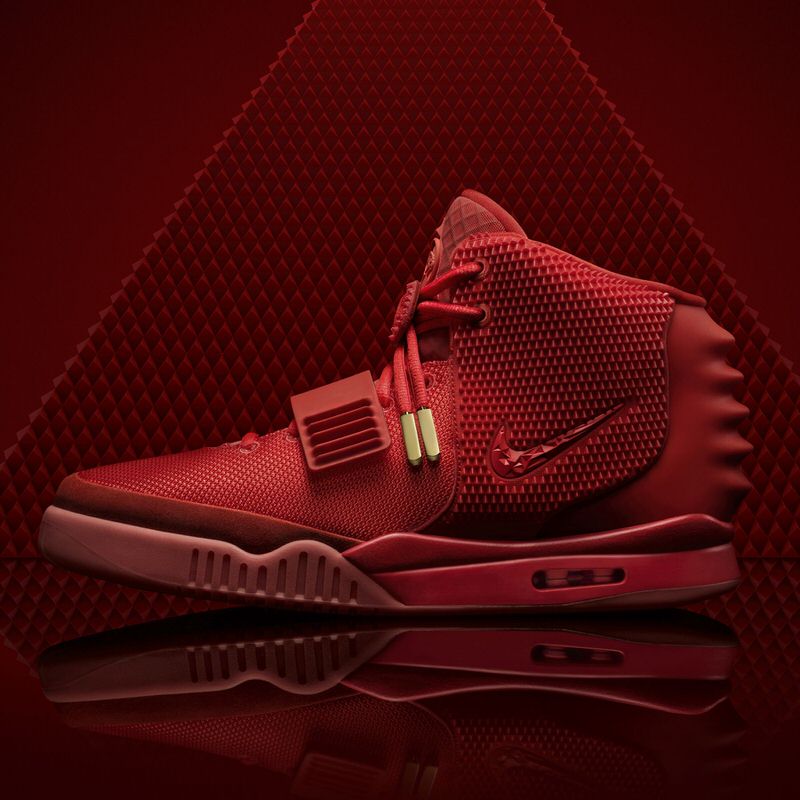
Love Kanye, hate Kanye, the 2010s were his.
Having a hand in some of the most celebrated work in music, fashion and footwear, all hit its peak or at least its predictor with the Nike Air Yeezy 2.
Coming off the success of 2009’s Air Yeezy 1, the sneaker world awaited a sequel to his introductory signature while the rest of the world became more enthralled by his fame thanks to a concoction of acclaimed albums, polarizing pop culture moments and a relationship with the world’s most watched woman.
By the time the Nike Air Yeezy 2 debuted in February of 2011, Kanye was already keeping up with the Kardashians and the paparazzi was snapping him from Paris to LA. By the time the Yeezy 2 actually released in June of 2012, Nike had a prolonged build up for a shoe that hadn’t been seen since Mike’s unsanctioned debut of the Concord Air Jordan 11 in the ’95 Playoffs.
The “Pure Platinum” and “Solar Red” Yeezy 2s would cause more commotion and reach more mainstream eyes than any of the previous pairs Ye did with Nike or Louis Vuitton up to that moment. The palettes crafted by West and Nike Sportswear’s Nathan VanHook would be stretched all across the category for the millions, and millions, of fans who couldn’t cop the Real McCoy at retail or resale. Sources say only 5,000 pairs of each Yeezy 2 launched in 2012. That’s a major void to fill between supply and demand.
Keeping the Yeezy 2 limited and playing out the palette might have been just what Nike wanted, but it was far from what Kanye had in mind. The lack of releases, royalties and resources requested by West in Beaverton brought on a beef that rings off much louder than Ye and 50 Cent’s September 11th showdown. Mad at Nike, mad at high fashion and maybe even mad at himself for allowing them to make him feel that way, Kanye released a fury of radio rants and stream of conscious complaints aimed at the Swoosh as the world first saw “Red Octobers” and first heard his most aggressive, abrasive album yet: Yeezus.
Like Air Yeezy launches before, the Red October 2s would be extremely limited, extremely popular and lag far behind in launch time to that of its unveiling. However, the folklore, flattery and floodgates they opened would be much more magnified.
First seen on the feet of Kanye in April 2013 – almost a year after the last Yeezy 2 launch and in NYC on SNL of all places – the Red October hype was beyond big and beyond real. Sources like The Shoe Game suggested the shoes would release in a Willy Wonka style golden ticket method hidden in hard copies of Yeezus while others suggest a then relatively unknown Virgil Abloh went into Nike and told them they were releasing shortly after Kanye wore them and Kim posted them to her multimillion following.
While Kanye has many famous Tweets, his announcement of a Red October Yeezy 2 giveaway in June of 2013 might be the most important to sneakerheads. Only handing out 50 pairs – far less than the 5,000 Pure Platinums or Solar Reds produced – a real Red October sighting in 2013 was rarer than spotting Big Foot.
Only months later, West would leave Nike sighting the Red October release as a major moment of contention. He would join adidas in November of 2013 while 2014 would see every brand in the market release every shoe they ever created in a triple-red rendition inspired by that of the Red Octobers.
Not to be outdone on a public stage, Nike made an even more famous Tweet in February of 2014 by releasing the Red October Yeezy 2 on Nike Store after Kanye had left. Pairs sold out in seconds, sneakerheads were shocked and nothing would ever be the same.
Hype and history aside, the Yeezy 2 paved the way for both musicians and modern designers to get shoe deals, triple-red to be just as popular as triple-black or triple-white and sent this decade’s biggest influencer to his former company’s biggest competitor.
Yes, the Yeezy 2 mattered that much.
4. Air Jordan 1 Banned
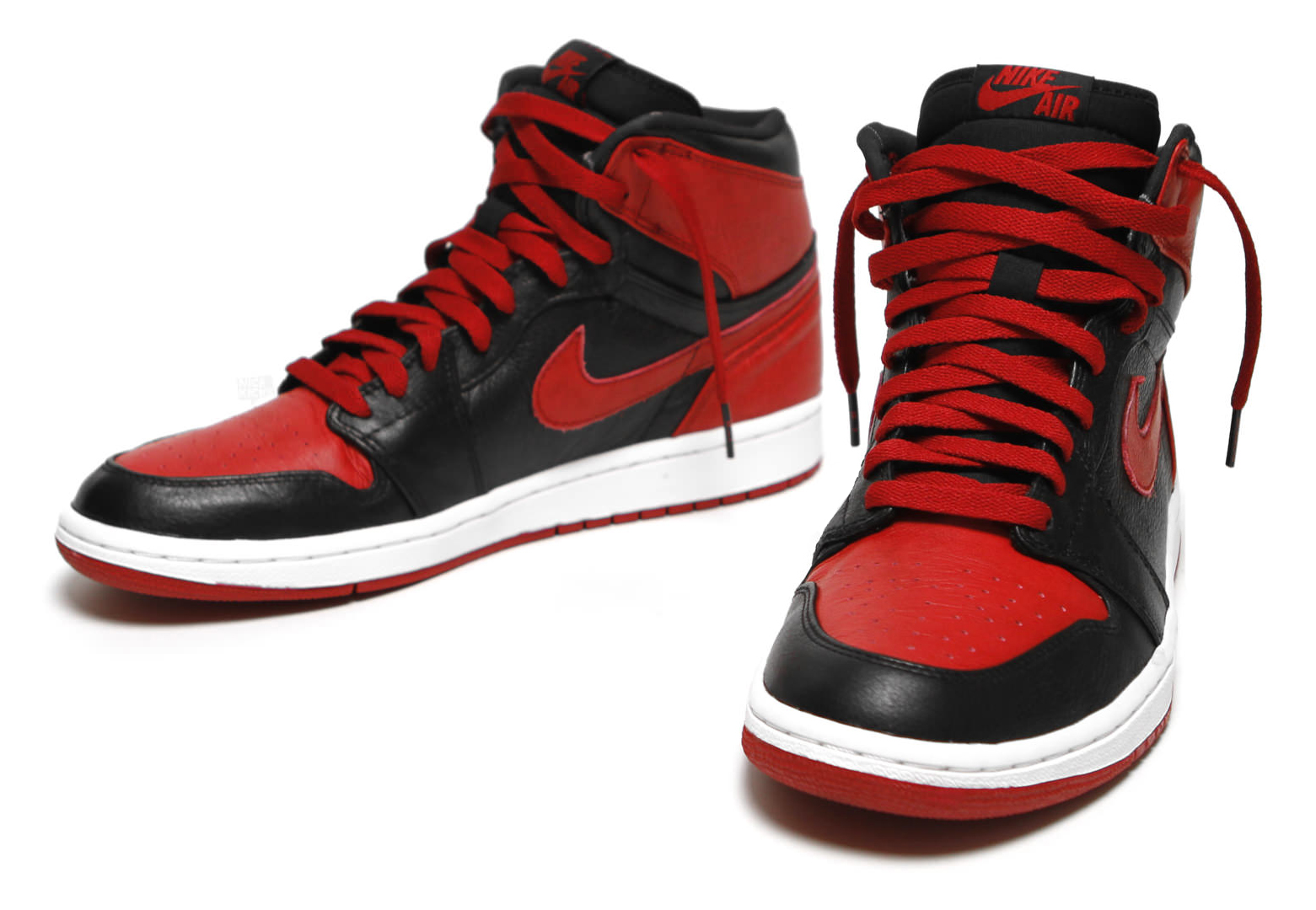
By the beginning of the 2010s, Air Jordan retros were red-hot. Suddenly it wasn’t just closet collectors congregating at mall or mom and pop shops two Saturdays a month to score the latest re-release, it was every kid across America lining up every weekend to spend hundreds on shoes far older than they were.
Despite designs 3 through 13 selling out Saturday after Saturday, the shoe that started it all, the Air Jordan 1, was cold as ice. Getting ran through the ringer of B-grade materials, Phat appropriations and discounted double drops in the late 2000s, the model’s slim cut didn’t take to the bulky build that both the hood and high fashion craved at the time. Ironically enough, another star from Chicago who prided himself off getting spins from Kay Slay while getting seats from Marc Jacobs would do exactly that in the 2010s.
The Air Jordan 1 Black/Red would become the shoe of choice for Kanye West in the first few years of the 2010s as he’d release genre shifting albums, wear internet breaking outfits and spearhead the convergence of hip-hop and designer luxury as we now know it.
In that same span of time, Jordan Brand would release the “Banned” Air Jordan 1 in 2011. Releasing randomly at Nike Factory Outlets of all places, it felt at the time like the move was made more so to bring energy to the brand’s liquidation stores than to make the AJ1 hot again. Nevertheless, a true chase, on-the-nose story and celebrity co-sign skyrocketed the OG Air Jordan from last place to first place all in the matter of a few years.
By the end of the decade, the Air Jordan 1 has arguably become more popular and more celebrated than all other Air Jordan models combined. OG colorways fetch top dollar each time they drop, collaborations top yearend lists on an annual basis and even the Mid which didn’t even exist in ’85 is gaining momentum as 2019 comes to a close.
In the 2010s, the 1 twice over became the new 11.
3. Nike LeBron 8 South Beach
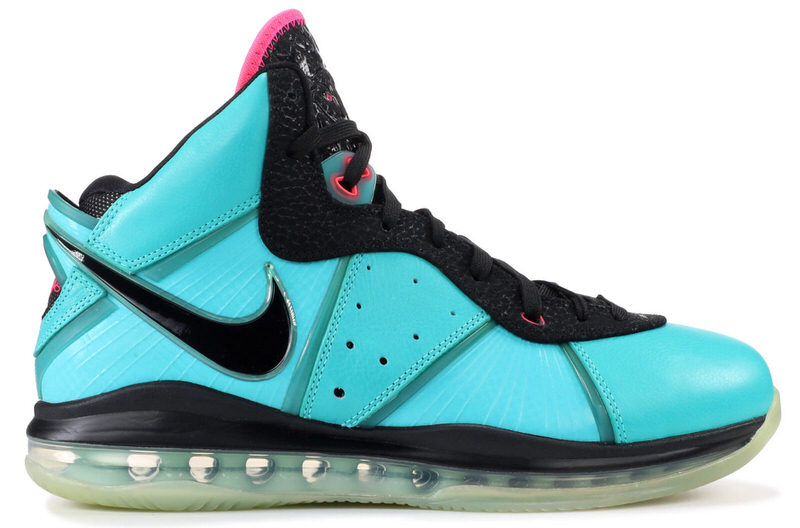
LeBron James’ public approval rating in winter of 2019 is at an all-time high. Leading the Lakers and also the league in assists, his rise as a philanthropist, public figure and 3x NBA Champion make the proud pops beloved across the nation and around the world.
In the fall of 2010, things were much different.
After seven season of endless MJ comparisons and critiques, The King had no rings and killer-instinct concerns kept his reign in question. Following a season of free-agency asks, MVPuppet commercials and an early playoff exit, LeBron James did something wildly unpopular.
He took his talents to South Beach.
All summer, all fall and all season, the world crucified LeBron James for both his departure from Cleveland and the fashion in which he did it. What the world forgets is that The Decision was less a point of pride and more a money maker for James and ESPN who raised a whopping $6 Million all for charity when combining broadcast and ad revenues. As they say, no good deed goes unpunished and suddenly LeBron James went from hero to villain.
Jordan jockers and Bryant backers already had enough barbershop banter to cut at the King’s cloth, but suddenly sports fans, national media and the whole Midwest had a reason to hate a guy who simply wanted to play ball with his friends and win over the world who wouldn’t love him until he won.
Whether Shakespeare or pop-culture, few protagonists reach their height without a fall and for LeBron it was the Fall of 2010. While it would take two tiles and a trip back home to Cleveland for the world to re-love him it would take sneakerheads far less: the Nike LeBron 8 South Beach.
The footwear equivalent to Michael Jackson’s Dangerous or Kanye West’s My Beautiful Dark Twisted Fantasy, LeBron’s best shoe would release at his most polarizing time, effectively condensing and strengthening his core fan base while giving doubters something they just couldn’t deny.
Though Bron never balled in the South Beach 8s, the release of said shoe completely shifted performance basketball footwear. For the first time since Mike’s infamous Air Jordan 11, kids and adults were camping out for a modern hoops shoe they didn’t dare take a jump shot in. This meteoric moment both boomed and doomed Nike Basketball for the 2010s.
Suddenly, every athlete on the Nike roster from rising stars like KD to retired legends like Penny had a ‘performance’ pair dropping twice a month in color stories ranging from Peanut Butter and Jelly sandwiches to Invisibility Cloak as if Hogwarts were in Memphis. Themes thrived and actual innovation dipped until they both met in the middle midway through the decade by way of another kid in Cleveland: Kyrie Irving.
Still, despite never playing in the South Beach 8, the LeBron series was more popular than ever and will never be the same. The shoe brought full-length Air back to retail even if it was rightly retired for roundball and gave the young King a shoe worthy of his majesty.
Long live LeBron.
2. adidas Ultra Boost
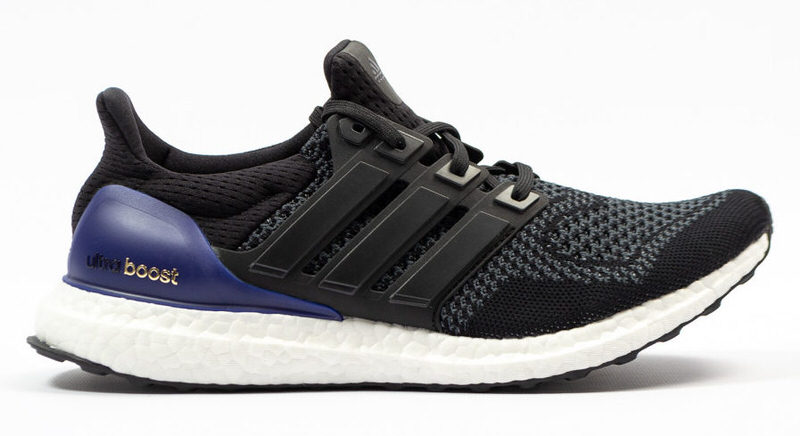
During New York Fashion Week in February of 2013, adidas flew in media from all over the world and sat down the likes of Big Sean and Rosario Dawson in the front row of a presentation to debut an innovation they said would “change running forever.”
It was Boost.
As legend would have it, the pellets made up of condensed proprietary thermoplastic urethane made by German chemical company BASF was passed on by Nike and sold to adidas. Upon launch, its aesthetic was panned by those that likened it to styrofoam while its feel was heralded by those able to try on the media seeded samples. “It feels like it’s alive” was commonly expressed by those with a literal foot in the game.
Despite designs derived from Engineered Mesh and rave reviews by those that used the Energy Boost for its intended use, sneaker culture was not buying Boost literally or figuratively.
In 2015, that all changed.
Enter the adidas Ultra Boost. Introduced in New York City just shy of two years after the tech’s unveiling, the Ultra Boost was being called the best shoe the brand ever made by people who know Stan Smith, forked over a hundo for Forums and saw Run-DMC claim the Superstar. This, keep in mind, is before pairs even hit shelves.
Hitting shelves, tracks and treadmills, the shoe was celebrated by runners but really hit kaboom when it was worn by a man who years earlier Tweeted that he jogged in Lanvin. Kanye West, performing in Chicago of all places in the all-white Energy Boost, provided the Black/Red Air Ship steeze to the all-white Ultra Boost just like Mike and Nike made Banned 1s a moment before he even donned them in the Dunk Contest.
With West’s wear of its predecessor and eventual endorsement of the actual UB, the Ultra Boost 1.0 was the toast of sneaker culture and the catalyst for both the brand and the tech. For the first time since Michael Jordan downed the Jazz in Game 6, the most popular shoe in sneaker culture was actually the best performance model in its category, too. The Air Max 360 did not live up to its hype on the track and even at the height of LeBron you typically had to stand at the height of LeBron to actually enjoy playing in his shoes. The Ultra Boost? Everything the brand said it was matched by every runner’s review of it.
After a rocky round of unjustified injury correlations on the hardwood and ahead of their time signings in hip-hop, adidas had finally found their breadwinner for the rest of the decade and taken the air out of the room to create the first truly competitive footwear market in 30 years.
The Stripes were back.
1. Nike Roshe Run
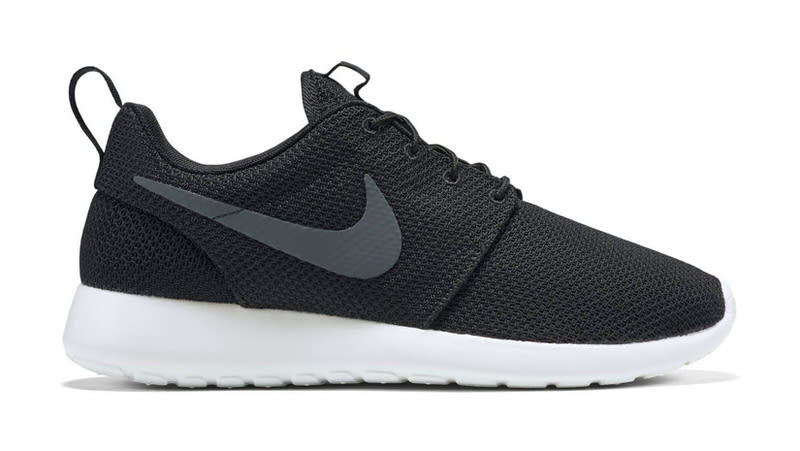
There would be no NMD, no 350, no All Birds and no other athletic appearing casual sneaker with running roots if it weren’t for the Nike Roshe Run.
Why? Because lifestyle running didn’t exist as a category before it.
Sure, the Swoosh was re-releasing Tinker and Tessler classics from yesteryear with no intention of a track and dropping functionless flexes like the Air Max 360 that proved the brand’s biggest innovation was marketing. However, it was Dylan Raasch’s $70 shocker that created a category and changed the entire game.
No new tech, no famous face, the Roshe Run was endorsed by no one and worn by everyone. The Zen mediation in minimalism proved to be water as Bruce Lee would put it, taking to every shape and spending habit while adapting to Nike’s newest fabrics like Flyknit, Tech Fleece and Jacquard.
While Woven updates, slipper styles and Yeezy riffs all penetrated the pockets of the style conscious, it was the inline OG that conquered the masses and created a worldwide demand for simple, comfortable shoes – word to Forrest Gump fans who wanted more cushion than a Cortez.
Like a Cee-Lo Green song, the shoe became over played by the mainstream, overran by the market and meme’d into submission by Four-Pins. Still, for teens of the early ’10s the Roshe Run serves as their Air Max 1, their Reebok Question and yes, even, their Air Jordan 1. It might be years before the Roshe gets a retro run like the shoes listed before it, but it’ll be a lot longer until the shoe’s impact wears off.
[ad_2]
Source link













